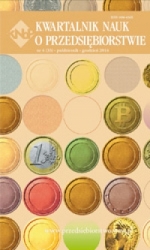Klastry jako katalizator rozwoju gospodarczego i myśli innowacyjnej
Main Article Content
Abstract
Ważnym elementem wzrostu innowacyjności polskiej gospodarki są klastry. W artykule został przedstawiony jeden z najdłużej działających – Dolina Lotnicza. Klaster skupia przedsiębiorstwa branży lotniczej i jest przykładem dynamicznego rozwój przemysłu high- tech. Ważną cechą Doliny Lotniczej jest również angażowanie się w innowacyjne projekty o charakterze międzynarodowym, co sprzyja rozszerzaniu sieci współpracy i partnerstwa na inne kraje i regiony – podkreśla autorka.
Downloads
Article Details
The author of the article declares that the submitted article does not infringe the copyrights of third parties. The author agrees to subject the article to the review procedure and to make editorial changes. The author transfers, free of charge, to SGH Publishing House the author's economic rights to the work in the fields of exploitation listed in the Article 50 of the Act of 4 February 1994 on Copyright and Related Rights – provided that the work has been accepted for publication and published.
SGH Publishing House holds economic copyrights to all content of the journal. Placing the text of the article in a repository, on the author's home page or on any other page is allowed as long as it does not involve obtaining economic benefits, and the text will be provided with source information (including the title, year, number and internet address of the journal).
References
2. Aydalot P. [1989], Innovative Environments in Europe, Paris, GREMI.
3. Aydalot P. [1984], Technologies nouvelles et developpement territorial, Groupe Technologies Nouvelleset Space, Paris, Sorbonne.
4. Bal-Woźniak T. [2012], Innowacyjność w ujęciu podmiotowym: uwarunkowania instytucjonalne, Warszawa, PWE.
5. Borek M. [2008], Historia sukcesu: Dolina Lotnicza, Innowacyjny Start, kwiecień, www.innowacyjnystart.pl/Archiwum.aspx?nr=8&Id=49, dostęp 11/09/2014.
6. Borowiecki R., Kwieciński M. [2004], (red.), Informacja i wiedza w zintegrowanym systemie zarządzania, Kraków, Zakamycze.
Szultka S. [2002], Koncepcja klastrów, a konkurencyjność przedsiębiorstw, Gdańsk, Instytut Badań nad Gospodarką Rynkową.
8. Gorynia M., Jankowska B. [2008], Klastry a międzynarodowa konkurencyjność i internacjonalizacja przedsiębiorstwa, Warszawa, Difin.
9. Hollensen S. [2003], Marketing Management: A Relationship Approach, Prentice Hall.
10. Karlsson Ch., Andersson A.E., Chesire P.C., Stough R.R. [2009], New Directions in Regional Economic Development, Advances in Spatial Science, Springer.
11. Ketels Ch. [2003], The Development of the cluster concept– present experiences and further developments, prepared for NRW conference on clusters, Duisburg, Germany, 5 December, [www.isc.hbs.edu/pdf/Frontiers_of_Cluster_Research_2003.11.23.pdf], dostęp 20/10/2014.
12. Kowalski A.M. [2013], Znaczenie klastrów dla innowacyjności gospodarki w Polsce, Warszawa, Oficyna Wydawnicza SGH.
13. Lentowicz Z. [2013], InnoLot rozwinie innowacje Doliny Lotniczej, Rzeczpospolita, 5 listopad, www.ekonomia.rp.pl/artykul/1062396.html, dostęp 11/09/2014.
14. Lundvall B.A. [1992], National Systems of Innovation. Towards a Theory of Innovation and Interactive Learning, London, Pinter Publishers.
15. Markusen A. [1996], Sticky places in slippery space. A typology of industrial districts, Economic Geography, No 3.
16. Mikołajczyk B. [2009], Klastry na świecie. Studia przypadków, Warszawa, Difin.
17. Nowakowska A. [2009], Budowanie zdolności innowacyjnych regionów, Łódź , Wydawnictwo Uniwersytetu Łódzkiego.
18. Porter M.E. [1998], On Competition, Boston, MA, Harvard Business Review Series.
19. Porter M.E. [1990], The Competitive Advantage of Nations, London, Macmillian.
20. Santarek K. [2008], Transfer technologii z uczelni do biznesu. Tworzenie mechanizmów transferu technologii, Warszawa, PARP.
21. Schumpeter J.A. [1934], The theory of economic development: an inquiry into profits, capital, credit, interest and the business cycle, Cambridge, Harvard University Press.
22. Skawińska E., Zalewski R.I. [2009], Klastry biznesowe w rozwoju konkurencyjności i innowacyjności regionów. Świat-Europa-Polska, Warszawa, PWE.
23. Stanienda J., Clusters in the system of region innovations, The Małopolska School of Economics in Tarnów Research Papers Collection, Vol. 19, Iss. 2, Tarnów 2011.

